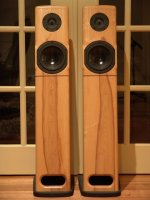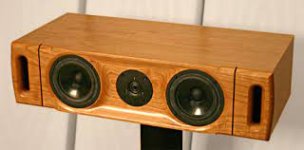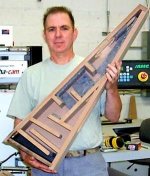Yep. I know you guyses are from the northern hinterland, and I am not familiar with your flora. This sure looks like what refer to down 'chere in the south as Pin Oak, or Water Oak. It grows predominantly in river bottoms and can reach gargantuan proportions. Though less stable than say a Red Oak or White Oak, it can yield some fantastic grain and is characterized by it's dark, sometimes almost black early wood, or spring growth. It is almost impossible to air dry. You may see that in the above photo as separation near the corners. That is some nice cabinetry, but left to it's own devices in a dry environment that enclosure might very well self-destruct. This is a criticism of the wood, not the woodworker. Very nice.Those FR boxes are beauties. I think that's an oak.
I love those builds.
He said it is Garry Oak.
https://en.wikipedia.org/wiki/Quercus_garryana
Pretty sure those were fully sealed in a cabinet shop.
He said it is Garry Oak.
https://en.wikipedia.org/wiki/Quercus_garryana
Pretty sure those were fully sealed in a cabinet shop.
Last edited:
but left to it's own devices in a dry environment that enclosure might very well self-destruct.
They were tortured just so, they “broke” and Bernie took them away and made them whole again. Any solid wood box needs extra care.
dave
I heard a lot about splitting and to avoid solid wood throughout speakers at all costs. I seen it done and I have done so personally at least 3-4 times. Companies like Monarch is one I can think of that used all wood, no veneer or plywood. Unless my memory is having a fart I think their "hotrods" are constructed of all oak.
I have done it, back before the internet came along to make me worry too much. But I used good pine woods that came pre laminated. The stuff you can buy in stores like Ikea under "shelving" boards. Its hardly as hard as oak but all wood expands and contracts.
The only time I seen solid oak come apart was when it was neglected. By neglected I mean left out for a few days to endure rain. Never mind the humidity that thing got drenched and stayed that way for days.
Furniture is built with that in mind. a good furniture builder will build reliefs for it right into the design to compensate for movement on things like hardwood table tops. That wasn't were my oak table split, all the joinery had held up. The lamination job from the factory let go in some places where the boards are laminated together to form larger boards. Some warpage was also evident before it looked completely dry.
Unless the air is terribly humid and drastically changes and often. I wouldn't worry about the FR boxes coming apart. There's a good chance they will be fine imo. I might just keep them in a room thats somewhat coltrolled with a closed door. Other than that what more could you do?
I have done it, back before the internet came along to make me worry too much. But I used good pine woods that came pre laminated. The stuff you can buy in stores like Ikea under "shelving" boards. Its hardly as hard as oak but all wood expands and contracts.
The only time I seen solid oak come apart was when it was neglected. By neglected I mean left out for a few days to endure rain. Never mind the humidity that thing got drenched and stayed that way for days.
Furniture is built with that in mind. a good furniture builder will build reliefs for it right into the design to compensate for movement on things like hardwood table tops. That wasn't were my oak table split, all the joinery had held up. The lamination job from the factory let go in some places where the boards are laminated together to form larger boards. Some warpage was also evident before it looked completely dry.
Unless the air is terribly humid and drastically changes and often. I wouldn't worry about the FR boxes coming apart. There's a good chance they will be fine imo. I might just keep them in a room thats somewhat coltrolled with a closed door. Other than that what more could you do?
Last edited:
Companies like Monarch is one I can think of that used all wood, no veneer or plywood
If the same Monarch as that that made the many loudspeakers i disassembled, they use the same plywood as many other Japanese descriptions.
Working with solid takes some knowledge of what you are doing. We have a few very capable members.
dave
Starting to read through this, I was thinking, man is there ever some 'splainin' to do about BB plywood.
Making it through, you guys have covered it nicely. Toolermike tops the list at this point but he hasn't mentioned anything about the peeling, glues, pressing or... hehe, just kidding.
Here's a link that seems to be an okay spot to place your bets.
https://plywoodlogistics.com/guide-to-baltic-birch-plywood-main-specifications-and-usages/
Making it through, you guys have covered it nicely. Toolermike tops the list at this point but he hasn't mentioned anything about the peeling, glues, pressing or... hehe, just kidding.
Here's a link that seems to be an okay spot to place your bets.
https://plywoodlogistics.com/guide-to-baltic-birch-plywood-main-specifications-and-usages/
I messed up the name, I should of said Meadowlark http://www.patmcginty.com/pow/osprey.htm
Apparently actually they did more than one with solid wood construction. The Osprey have not one but four different species of hardwood.
"Seen side by side are Ospreys dressed in Pennsylvania Cherry with a Rock Maple Stringer and in Light Ash with a Heritage Walnut Stringer. The baffle and top sections are deeply sculpted from wood solids, then carefully finished by hand to achieve a radiant depth of character and deep glow that simply cannot be mimicked by even the best of today’s artificial materials."
Rock maple walnut and ash.
All may have opposing shrink rates, a good chance, to make the build that much more of a challenge. My guess they have a big beautiful kiln over there to get them ballpark in terms of dryness rates first of all.
Apparently actually they did more than one with solid wood construction. The Osprey have not one but four different species of hardwood.
"Seen side by side are Ospreys dressed in Pennsylvania Cherry with a Rock Maple Stringer and in Light Ash with a Heritage Walnut Stringer. The baffle and top sections are deeply sculpted from wood solids, then carefully finished by hand to achieve a radiant depth of character and deep glow that simply cannot be mimicked by even the best of today’s artificial materials."
Rock maple walnut and ash.
All may have opposing shrink rates, a good chance, to make the build that much more of a challenge. My guess they have a big beautiful kiln over there to get them ballpark in terms of dryness rates first of all.
Last edited:
How bout that sculpted baffle? These are transmission line Kestrels.
Others in ash http://www.patmcginty.com/swallowold.htm The sides seem to be veneered on that one. I got word that ash isn't as widely used at it used to be. Which is huge in regards to baseball bats https://www.nytimes.com/2022/10/20/sports/baseball/ash-bats-baseball.html
Those stupid Asian tree beetles. They got one of our trees too.
Others in ash http://www.patmcginty.com/swallowold.htm The sides seem to be veneered on that one. I got word that ash isn't as widely used at it used to be. Which is huge in regards to baseball bats https://www.nytimes.com/2022/10/20/sports/baseball/ash-bats-baseball.html
Those stupid Asian tree beetles. They got one of our trees too.
Attachments
Last edited:
- Home
- Design & Build
- Construction Tips
- the real deal?


